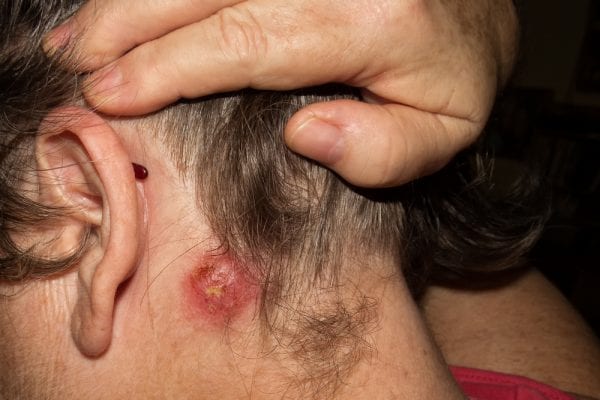
Staphylococcus bacteria is commonly found on human skin and causes no adverse reactions at all.2 However, these bacteria can cause minor skin irritations in some people, and it can even be life-threatening if the infection reaches the heart, lungs, or joints.1 Anyone can develop a staph infection, but certain people are more at risk for them, such as individuals with chronic conditions, individuals with weakened immune systems, and newborn babies.
This article will explore staph infections, including the causes, common staph infection symptoms, and staph infection joint pain locations in the body. It will also address treatment options to relieve joint pain and other symptoms of this condition.
Staph Infection Causes
It is very common for a person to have staph bacteria on the skin and never even know it or develop a staph infection at all.3 However, this type of infection can be spread from one person to another and even live on objects around the house, such as sheets and towels. It is more likely for a person to develop a staph condition if they have underlying health conditions like diabetes, HIV/AIDS, respiratory illnesses, an immune system disorder, or cancer.4
Staph Infection Symptoms
Most commonly, a staph infection appears on the skin in the form of a boil, which is a red and swollen area of the skin that is inflamed and filled with pus.1 A staph infection may also cause impetigo, which is a contagious and painful rash with blisters and oozing fluid. Cellulitis may result if the deeper layers of skin and tissue become infected.5 This type of bacteria is also a common cause of food poisoning, toxic shock syndrome, and a blood poisoning disorder called septicemia.6 Finally, a staph infection can cause septic arthritis, which is a condition involving severe joint pain and swelling.7
Locations of Staph Infection Joint Pain
Staph infections are most commonly found in the armpit and around the groin and buttocks areas. However, joint pain that is caused by a staph infection more commonly affects the hips, knees, shoulders, fingers, and toes.8 The joint pain and swelling in the affected joint may be severe and accompanied by fever. People who have existing joint problems have suffered a joint trauma, or who are taking medication for rheumatoid arthritis are more at risk of developing septic arthritis.9
Staph Infection Treatment Options
If a person’s joint pain is caused by a staph infection, there is a good chance it will subside when the infection goes away.8 Antibiotics are often prescribed to treat a staph infection; however, many strands of staph have become resistant to commonly used antibiotics.1,3 A physician may also recommend wound drainage to eliminate the fluid in staph infection sores. If you suspect you have a staph infection, you should consult with your doctor about appropriate treatment. If there is not an open wound in the affected area, your doctor may recommend a joint cream, such as JointFlex®, to help alleviate your painful symptoms. If a significant amount of fluid has collected at a joint, it may be necessary to remove the fluid with a needle or perform a scope procedure that involves inserting drainage tubes through a small incision. If a diagnosis of septic arthritis is made, it is very important to determine the microbe that is causing the infection and begin administering treatment immediately.
REFERENCES for STAPH INFECTIONS and JOINT PAIN
1. Bush, L. M. (2018 May). Staphylococcus aureus infections. The Merck Manual: Consumer Version. Retrieved October 19, 2018 from https://www.merckmanuals.com/home/infections/bacterial-infections-gram-positive-bacteria/staphylococcus-aureus-infections.
2. Staphylococcal infections. MedlinePlus. Retrieved October 17, 2018 from https://medlineplus.gov/staphylococcalinfections.html.
3. Methicillin-resistant staphylococcus aureus (MRSA). Centers for Disease Control and Prevention. Retrieved October 18, 2018 from https://www.cdc.gov/mrsa/community/index.html.
4. Healthcare-associated infections. Centers for Disease Control and Prevention. Retrieved October 18, 2018 from https://www.cdc.gov/hai/organisms/staph.html.
5. Dhar, A. S. (2017 November). Cellulitis. The Merck Manual: Consumer Version. Retrieved October 18, 2018 from https://www.merckmanuals.com/home/skin-disorders/bacterial-skin-infections/cellulitis.
6. Septicemia. Johns Hopkins Medicine. Retrieved October 17, 2018 from https://www.hopkinsmedicine.org/healthlibrary/conditions/nervous_system_disorders/septicemia_85,P00802.
7. Infectious arthritis. MedlinePlus. Retrieved October 18, 2018 from https://medlineplus.gov/infectiousarthritis.html.
8. Infectious arthritis. Arthritis Foundation. Retrieved October 18, 2018 from https://www.arthritis.org/about-arthritis/types/infectious-arthritis/.
9. Schmitt, S. (2017 May). Infectious arthritis. The Merck Manual: Consumer Version. Retrieved October 18, 2018 from https://www.merckmanuals.com/home/bone,-joint,-and-muscle-disorders/bone-and-joint-infections/infectious-arthritis.
